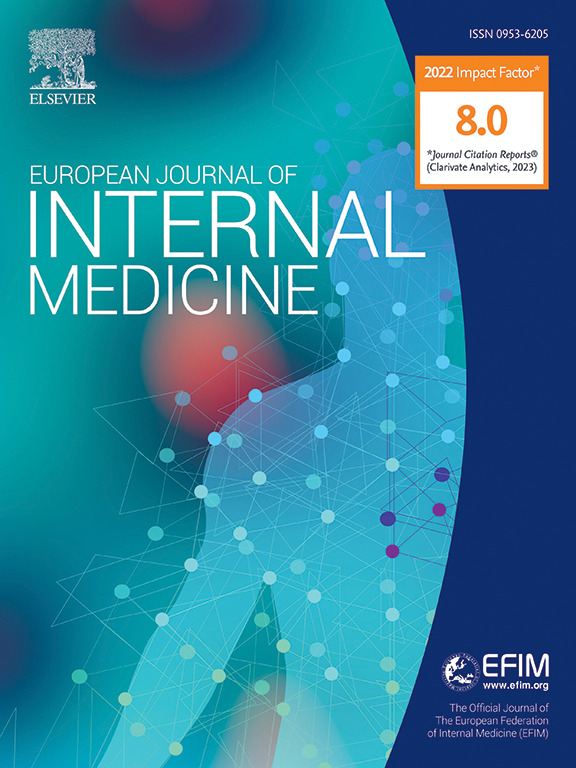用 HAS-BLED 和 DOAC 评分预测接受直接口服抗凝剂治疗的心房颤动患者的大出血事件:欧洲前瞻性观察登记报告。
IF 5.9
2区 医学
Q1 MEDICINE, GENERAL & INTERNAL
引用次数: 0
摘要
背景:最近提出的 DOAC 评分用于对接受直接口服抗凝剂(DOAC)治疗的房颤患者进行出血风险分层:最近有人提出用DOAC评分对接受直接口服抗凝剂(DOAC)治疗的房颤患者进行出血风险分层:比较 HAS-BLED 和 DOAC 评分在预测接受 DOAC 治疗的欧洲心房颤动患者的大出血事件方面的性能:我们纳入了来自欧洲房颤患者前瞻性观察登记处的患者。HAS-BLED和DOAC评分按原始方案计算。我们的主要终点是大出血事件。采用受体操作特征曲线(ROC)比较评分的预测能力:共有 2834 名接受 DOAC 治疗的房颤患者(中位年龄 [IQR] 69 [62-77] 岁;39.6% 为女性)被纳入分析。根据 HAS-BLED 评分,577 名患者(20.4%)被归类为出血风险极低,而根据 DOAC 评分,1276 名患者(45.0%)被归类为出血风险极高。共发生 55 例大出血,总发生率为每 100 患者年 1.04 例。两种评分对出血事件的预测能力都不强(HAS-BLED 曲线下面积 [AUC],0.65,95% 置信区间 [CI],0.55-0.70;DOAC 评分 AUC,0.62,95% 置信区间 [CI],0.59-0.71,差异 p = 0.332)。在校准分析中,与HAS-BLED相比,DOAC评分显示出适度的校准,尤其是对高危患者而言:结论:在DOAC治疗的当代房颤患者队列中,HAS-BLED和DOAC评分只能适度预测大出血事件的发生。我们的结果不支持优先使用 DOAC 评分而非 HAS-BLED。本文章由计算机程序翻译,如有差异,请以英文原文为准。
Performance of HAS-BLED and DOAC scores to predict major bleeding events in atrial fibrillation patients treated with direct oral anticoagulants: A report from a prospective European observational registry
Background
The DOAC score has been recently proposed for bleeding risk stratification of patients with atrial fibrillation treated with direct oral anticoagulants (DOAC).
Objective
To compare the performance of HAS-BLED and DOAC score in predicting major bleeding events in a contemporary cohort of European AF patients treated with DOAC.
Methods
We included patients derived from a prospective observational registry of European AF patients. HAS-BLED and DOAC scores were calculated as per the original schemes. Our primary endpoint was major bleeding events. Receiver operating characteristic (ROC) curves were used to compare the predictive ability of the scores.
Results
A total of 2834 AF patients (median age [IQR] 69 [62–77] years; 39.6 % female) treated with DOAC were included in the analysis. According to the HAS-BLED score, 577 patients (20.4 %) were categorized as very low risk of bleeding, as compared to 1276 (45.0 %) according to DOAC score. A total of 55 major bleeding events occurred with an overall incidence of 1.04 per 100 patient-years. Both scores showed only a modest ability for the prediction of bleeding events (HAS-BLED area under the curve [AUC], 0.65, 95 % confidence interval [CI] 0.55–0.70; DOAC score AUC 0.62, 95 % CI 0.59–0.71, p for difference = 0.332]. At calibration analysis, the DOAC score showed modest calibration, especially for patients at high risk, when compared to HAS-BLED.
Conclusion
In a contemporary cohort of DOAC-treated AF patients, both HAS-BLED and DOAC scores only modestly predicted the occurrence of major bleeding events. Our results do not support the preferential use of DOAC score over HAS-BLED.
求助全文
通过发布文献求助,成功后即可免费获取论文全文。
去求助
来源期刊
CiteScore
9.60
自引率
6.20%
发文量
364
审稿时长
20 days
期刊介绍:
The European Journal of Internal Medicine serves as the official journal of the European Federation of Internal Medicine and is the primary scientific reference for European academic and non-academic internists. It is dedicated to advancing science and practice in internal medicine across Europe. The journal publishes original articles, editorials, reviews, internal medicine flashcards, and other relevant information in the field. Both translational medicine and clinical studies are emphasized. EJIM aspires to be a leading platform for excellent clinical studies, with a focus on enhancing the quality of healthcare in European hospitals.

 求助内容:
求助内容: 应助结果提醒方式:
应助结果提醒方式:


